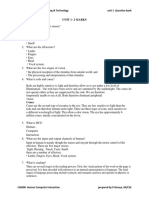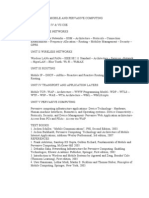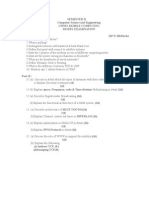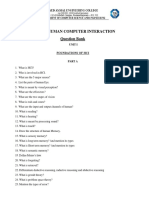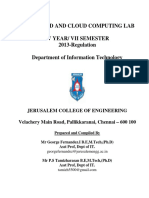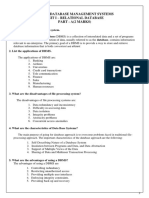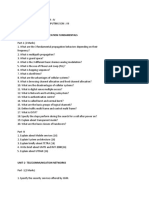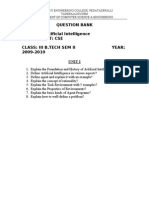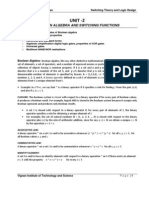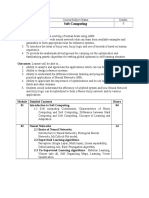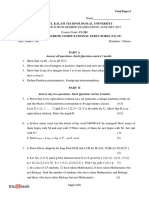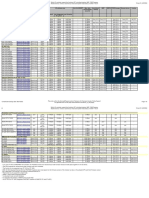0 ratings0% found this document useful (0 votes)
128 viewsEC360 Soft Computing - Syllabus PDF
This document outlines the course objectives, syllabus, expected outcomes, and course plan for a Soft Computing course offered in 2016. The course introduces concepts of fuzzy logic, neural networks, and genetic algorithms. It covers topics like fuzzy sets and relations, neural network architectures, backpropagation, and genetic algorithms. Students are expected to learn how to apply soft computing techniques to problems involving pattern classification, optimization, and more. The course is assessed through internal exams, assignments, and an end semester exam involving both theoretical and practical questions.
Uploaded by
voxovCopyright
© © All Rights Reserved
Available Formats
Download as PDF, TXT or read online on Scribd
0 ratings0% found this document useful (0 votes)
128 viewsEC360 Soft Computing - Syllabus PDF
This document outlines the course objectives, syllabus, expected outcomes, and course plan for a Soft Computing course offered in 2016. The course introduces concepts of fuzzy logic, neural networks, and genetic algorithms. It covers topics like fuzzy sets and relations, neural network architectures, backpropagation, and genetic algorithms. Students are expected to learn how to apply soft computing techniques to problems involving pattern classification, optimization, and more. The course is assessed through internal exams, assignments, and an end semester exam involving both theoretical and practical questions.
Uploaded by
voxovCopyright
© © All Rights Reserved
Available Formats
Download as PDF, TXT or read online on Scribd
You are on page 1/ 2
COURSE YEAR OF
CODE COURSE NAME L-T-P-C INTRODUCTION
EC360 Soft Computing 3-0-0 -3 2016
Prerequisite: NIL
Course objectives:
1. To familiarize various components of soft computing like fuzzy logic, neural networks
and genetic algorithm.
2. To give an overview of fuzzy Logic and to understand the concepts and terminologies of
fuzzy systems
3. To give a description on artificial neural networks with its advantages and application.
4. To study the fundamentals of Genetic Algorithm (GA).
5. To understand the concepts of hybrid systems.
Syllabus:
Fuzzy sets and systems. Neural Networks - Applications - typical architecture, pattern
Classification and pattern Association. Fundamentals of Genetic Algorithm, AI search
algorithm and hybrid structure.
Expected outcome:
The students will be able to:
1. Identify and describe soft computing techniques and their roles in building intelligent
Machines.
2. Apply fuzzy logic and reasoning to handle uncertainty and solve engineering problems
3. Recognize the feasibility of applying a soft computing methodology for a particular
Problem.
4. Apply neural networks to pattern classification and regression problems.
5. Apply genetic algorithms to combinatorial optimization problems
Text Books:
1. D.E. Goldberg, "Genetic Algorithms: Search, Optimization and Machine Learning",
Addison Wesley,N.Y, 1989.
2. Laurene V. Fausett, (1993) “Fundamentals of Neural Networks: Architecture,
Algorithms and Applications", Prentice Hall.
3. Timothy J. Ross, “Fuzzy Logic with Engineering Applications” Wiley India.
References:
1. Ibrahim A. M., Introduction to Applied Fuzzy Electronics, PHI, 2013.
2. J. Yen and R. Langari, Fuzzy Logic, Intelligence, Control and Information, Pearson
Education.
3. K.H.Lee, First Course on Fuzzy Theory and Applications, Springer-Verlag.
4. Lin C. T. and C.S. G. Lee, Neural Fuzzy Systems, Prentice Hall, 1996.
5. S. Rajsekaran & G.A. Vijayalakshmi Pai, “Neural Networks, Fuzzy Logic and Genetic
Algorithm: Synthesis and Applications” Prentice Hall of India.
6. S.N. Sivanandan and S.N. Deepa, Principles of Soft Computing, Wiley India, 2007.
ISBN: 10: 81-265-1075-7.
Course Plan
Module Course content End
Sem.
Hours
Exam
Marks
Soft computing: Introduction, soft computing vs hard
computing, Fuzzy Computing, Neural Computing, Genetic 2
Algorithms. applications of soft computing
Introduction to fuzzy sets and systems-crispness, vagueness, 15
I
uncertainty and fuzziness. Basics of fuzzy sets, membership
3
functions, support of a fuzzy set height, normalized fuzzy set,
alpha cuts.
Type- 2 fuzzy sets. Operation on fuzzy set-complement,
4
intersection, union, Demorgan's Law Equality & subset hood.
II Extension Principle and its application, Fuzzy relation- 15
operations, projection, max-min, min-max composition, 3
cylindrical extension.
FIRST INTERNAL EXAM
Reflexivity, symmetry and transitivity of fuzzy relations. Fuzzy
4
prepositions, fuzzy connectives, linguistic variables, hedges.
III Approximate reasoning or fuzzy inference, Fuzzy rule based 15
system. Fuzzification and defuzzification using centroid, centre 4
of sums.
Introduction to Neural Networks - Applications –Biological
neuron- Typical architecture of Artificial Neural Networks - 4
IV Common activation function. 15
McCulloh Pitts Neuron – Architecture, logic implementatons.
4
Supervised and Unsupervised learning
SECOND INTERNAL EXAM
Linear Separability, Pattern Classification: Perceptrons 2
V Back propagation network and its architecture, Back 20
4
propagation learning, back propagation algorithm
Genetic Algorithm Basic concepts, Initialization and selection,
5
VI Survival of the Fittest - Fitness Computations. 20
Operators - Cross over, Mutation. 3
END SEMESTER EXAM
Question Paper ( End semester exam)
Max. Marks: 100 Time : 3 hours
The question paper shall consist of three parts. Part A covers modules I and II, Part B covers
modules III and IV, and Part C covers modules V and VI. Each part has three questions
uniformly covering the two modules and each question can have maximum four subdivisions.
In each part, any two questions are to be answered. Mark patterns are as per the syllabus
with 50 % for theory, derivation, proof and 50% for logical/numerical problems.
You might also like
- Cs6303 - Computer Architecture Question Bank Unit-I Overview & Instructions Part - A (2 MARKS)No ratings yetCs6303 - Computer Architecture Question Bank Unit-I Overview & Instructions Part - A (2 MARKS)4 pages
- COMP 577 - Soft Computing Techniques: Chapter - 1: IntroductionNo ratings yetCOMP 577 - Soft Computing Techniques: Chapter - 1: Introduction2 pages
- Mobile Computing EEM 825/ PEE411 Credits:4: Syllabus100% (1)Mobile Computing EEM 825/ PEE411 Credits:4: Syllabus6 pages
- Icles' Motilal Jhunjhunwala College, Vashi IT& CS DepartmentNo ratings yetIcles' Motilal Jhunjhunwala College, Vashi IT& CS Department41 pages
- Cse-Vii-java and J2EE (10cs753) - Question PaperNo ratings yetCse-Vii-java and J2EE (10cs753) - Question Paper4 pages
- Grammar - English Aptitude MCQ Questions and AnswersNo ratings yetGrammar - English Aptitude MCQ Questions and Answers4 pages
- Wrapper Classes Exercise: Cognizant Technology SolutionsNo ratings yetWrapper Classes Exercise: Cognizant Technology Solutions7 pages
- Cs8492 - Database Management Systems Unit I - Relational Database Part - A (2 Marks)No ratings yetCs8492 - Database Management Systems Unit I - Relational Database Part - A (2 Marks)27 pages
- Unit-1 Wireless Communication FundamentalsNo ratings yetUnit-1 Wireless Communication Fundamentals5 pages
- Question Bank COURSE: Artificial Intelligence Department: Cse Class: Iii B.Tech Sem Ii Year: 2009-2010 Unit INo ratings yetQuestion Bank COURSE: Artificial Intelligence Department: Cse Class: Iii B.Tech Sem Ii Year: 2009-2010 Unit I9 pages
- AI-ques-ans-Unit-1 Prof. Anuj Khanna KOITNo ratings yetAI-ques-ans-Unit-1 Prof. Anuj Khanna KOIT17 pages
- How To Build A Mutual Fund Portfolio: The Debt-Equity RatioNo ratings yetHow To Build A Mutual Fund Portfolio: The Debt-Equity Ratio10 pages
- Operations Research Lecture 1: Introduction To OR Models: Kusum Deep Mathematics DepartmentNo ratings yetOperations Research Lecture 1: Introduction To OR Models: Kusum Deep Mathematics Department44 pages
- Gate Questions On Pumping Lemma - Theory of Computation - AcademyEra PDFNo ratings yetGate Questions On Pumping Lemma - Theory of Computation - AcademyEra PDF3 pages
- Natural Computing with Python: Learn to implement genetic and evolutionary algorithms to solve problems in a pythonic wayFrom EverandNatural Computing with Python: Learn to implement genetic and evolutionary algorithms to solve problems in a pythonic wayNo ratings yet
- Total Pages: 3: Apj Abdul Kalam Technological UniversityNo ratings yetTotal Pages: 3: Apj Abdul Kalam Technological University3 pages
- 1 CS201 - Discrete - Computational - Structures - QP PDFNo ratings yet1 CS201 - Discrete - Computational - Structures - QP PDF3 pages
- History & Organization Of A Μp Based System: Mr. Ramesh C R Asst. Professor, Doece, VastNo ratings yetHistory & Organization Of A Μp Based System: Mr. Ramesh C R Asst. Professor, Doece, Vast15 pages
- EC360 Important University Questions PDFNo ratings yetEC360 Important University Questions PDF4 pages
- Aaaaainsert Your First Table of ContentsNo ratings yetAaaaainsert Your First Table of Contents7 pages
- Draft Filsfils Spring srv6 Network Programming 07No ratings yetDraft Filsfils Spring srv6 Network Programming 0742 pages
- Lab3 - Deploying The Kubernetes Cluster - Node2100% (1)Lab3 - Deploying The Kubernetes Cluster - Node28 pages
- Impact of Artificial Intelligence On Recruitment and Selection ofNo ratings yetImpact of Artificial Intelligence On Recruitment and Selection of7 pages
- Full Cyber Security Power and Technology Martti Lehto PDF All Chapters100% (3)Full Cyber Security Power and Technology Martti Lehto PDF All Chapters53 pages
- 6th Merit List BS Artificial Intelligence Group A Department of Artificial Intelligence BAHAWALPUR BWP Merit Fall 2024 Fall 2024No ratings yet6th Merit List BS Artificial Intelligence Group A Department of Artificial Intelligence BAHAWALPUR BWP Merit Fall 2024 Fall 20246 pages
- Model Name: GA-B75M-D2V: Gigabyte TechnologyNo ratings yetModel Name: GA-B75M-D2V: Gigabyte Technology26 pages
- Amt Ltrs Amt LTRS: Default Setting Is 1111"No ratings yetAmt Ltrs Amt LTRS: Default Setting Is 1111"105 pages
- User Manual Toshiba Portégé Z20t-C (English - 145 Pages)No ratings yetUser Manual Toshiba Portégé Z20t-C (English - 145 Pages)2 pages
- Designing A Website Using Website BuilderNo ratings yetDesigning A Website Using Website Builder32 pages
- Activity 3.3 Thesis, Topic Sentence and Supporting Details-1No ratings yetActivity 3.3 Thesis, Topic Sentence and Supporting Details-13 pages
- Image-Based Food Classification and Volume Estimation For Dietary Assessment A ReviewNo ratings yetImage-Based Food Classification and Volume Estimation For Dietary Assessment A Review14 pages

